
© » KADIST
Choi Jeong-Hwa
The application of bright colors and kitsch materials in Flower Tree manifests a playful comment on the influence of popular culture and urban lifestyle. And though his works share a similar sensibility to Claes Oldenburg’s oversized sculptures from everyday objects, Choi draws from his immediate surroundings and life experience. Public sculptures with a flower theme are often used to decorate the rapidly urbanized cities in Asia, which are constructed with concrete and steel materials.

© » KADIST
Kwan Sheung Chi
A Flags-Raising-Lowering Ceremony at my home’s cloths drying rack (2007) was realized in the year of the 10th anniversary of the establishment of The Hong Kong Special Administrative Region of the People’s Republic of China. The artist asked his parents to perform a flags-raising-lowering ceremony on their home’s cloths drying rack, with the HKSAR regional flag, and the flags of PRC and The UK. Artist Lee Kit hand-painted the HKSAR regional flag following the detail instructions in “The State’s Standards of The People’s Republic of China, GB16689-1996”, issued by The State Authority of Technical Monitoring.
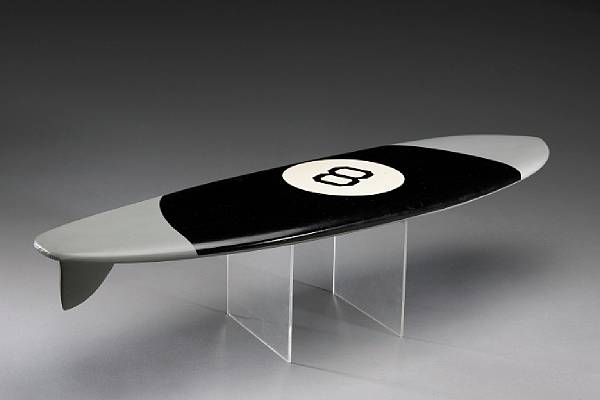
© » KADIST
Alexis Smith
In 8 Ball Surfboard (1995),Alexis Smith combines her long-term interests in California culture and conceptual assemblage. The surfboard, an emblem of Southern California, emblazoned with the image of an eight-ball, references numerous tropes and clichés of American popular culture, specifically subcultures related to pool halls, surfing, and beaches. Indeed, this model-scale surfboard may be a future pop-culture relic, referencing a particular surfer or era of board design.

© » KADIST
Kwan Sheung Chi
Kwan Sheung Chi’s work One Million is a video work depicting the counting of bills. Divided into three versions, the video first shows a number of Japanese ten-thousand-yen bills being counted without in an orderly, efficient manner. In Two Million , a similar counting of one-thousand-dollar bills from Hong Kong follows.

© » KADIST
Zai Kuning
Justice (2014) presents viewers with a curious assemblage: a wooden gallows with slightly curved spindles protruding from the topmost plank, which in turn is covered with rudimentary netting, the threads slackly dangling like a loose spider’s web or an rib cage that’s been cracked open. A bundle of small red rattan balls hang from the front end of the plank, precariously knotted to a single thread hanging from the gallows’ edge. A book hangs from similar red threads at the plank’s rear, its surfaced wrapped multiple times over with the thread to hold it in place, the red thread resembling blood vessels or connective tissue.

© » KADIST
Bjorn Copeland
Sign #1 , Sign #2 , Sign #3 were included in “Found Object Assembly”, Copeland’s 2009 solo show at Jack Hanley Gallery, San Francisco. These rather austere collages were created by simply cutting and inverting the text from existing information signs. In Sign #2 , for example, the original image that presumably carried the message “NO RIDERS” was placed upside down.

© » KADIST
Zai Kuning
Drawing & Print (Drawing & Print)
Converting is a piece about the Orang Laut, often called Sea Nomads, that inhabited the Riau archipelago. They were Christians and pagans that were often oppressed by the majority Muslims in the Riau community and were eventually forced to convert to Islam. Zai conveyed this history in Converting through the stark contrasts of red, white, black.

© » KADIST
Zai Kuning
Drawing & Print (Drawing & Print)
Concerned with the early history of Singapore, Zai Kuning spent many years living with and researching the history of the Riau peoples who were the first inhabitants of Singapore. Inspired by the women of Riau, Back to Mother seemingly traces the central role of maternal figures in nourishing of Riau’s history as an early archipelago kingdom that was Hindu, Buddhist, and animist prior to 14th-century Muslim invasion. Organic materials such as beeswax form a layer of balm protecting threads of red paint symbolic bloodlines in a turtle-formed mandala—a primordial womb that recalls the Hindu and animistic origin of Singaporean society.

© » KADIST
Kwan Sheung Chi
One Million is a video work depicting the counting of bills. Divided into three versions, the video first shows a number of Japanese ten-thousand-yen bills being counted without in an orderly, efficient manner. In Two Million , a similar counting of one-thousand-dollar bills from Hong Kong follows.
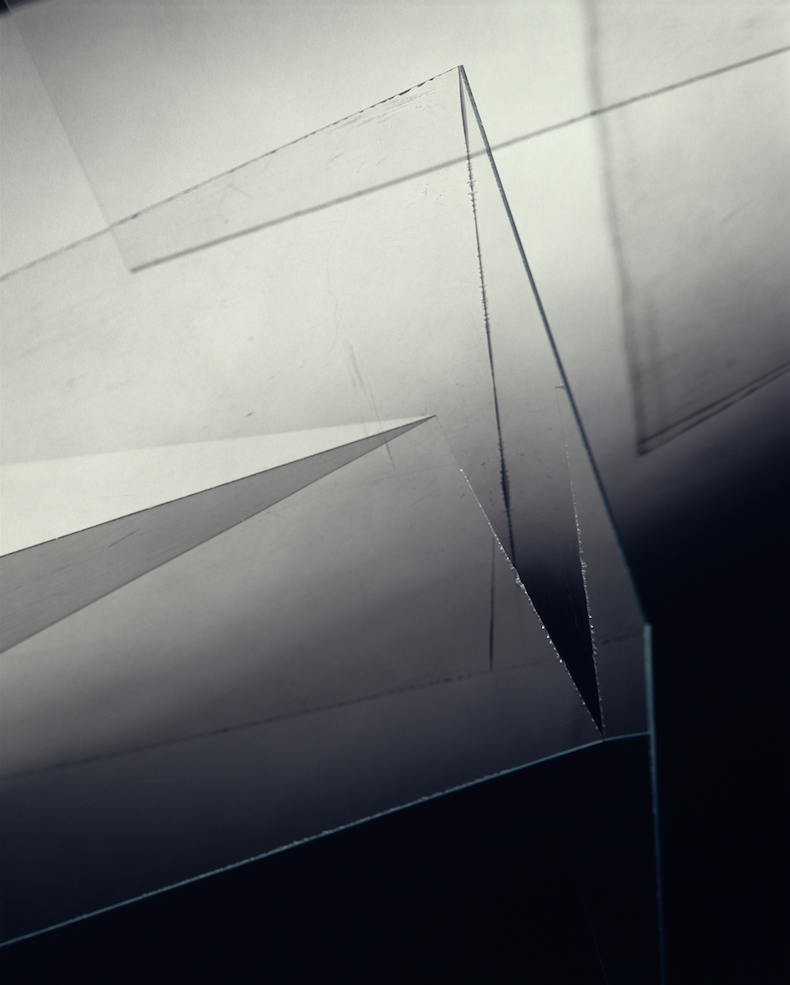
© » KADIST
Barbara Kasten
Barbara Kasten’s Studio Construct 51 depicts an abstract still life: a greyscale photograph of clear translucent panes assembled into geometric forms, the hard lines of their edges converging and bisecting at various points. Light streams from unseen sources and projects rectangular shadows against an adjacent wall. Three-dimensional shapes become suddenly flat as the objects in Kasten’s still life are juxtaposed alongside their ghostly traces.

© » KADIST
Minouk Lim
New Town Ghost (2005) is one of Lim’s trio of large-scale video installations. (The other two are S. O. S—Adoptive Dissensus [2009] and The Weight of Hands [2010].) The series grew out of her interest in capturing lost memories and the collective unconscious in rapidly globalizing cities such as Seoul.

© » KADIST
Yoan Capote
Open Mind is a model created by Capote for a traversable public maze that, when seen from above, resembles the human brain. Because individual movement through the maze echoes the movement of neurons and a larger aggregated whole, visitors can be seen to enact a model of sociality and public space that both embodies and metaphorizes social consciousness. Capote’s model shows not just the proposed structure, but features figurines as well, to illustrate the possible scale and interactivity of the final piece.

© » KADIST
Bruce Conner
In 1977, as an already-established artist best known for his films, Bruce Conner began to photograph punk rock shows at Mabuhay Gardens, a San Francisco club and music venue. 27 Punk Photos: 11. Dim Wanker: F Word, May, 1978 (1978) is representative of a series of photographs by Conner, whose subject became a fascination for the artist.

© » KADIST
Alexandre da Cunha
His Deck Painting I recalls the simplistic stripes of conceptual artist Daniel Buren, or the minimal lines of twentieth century abstract painting, but is in reality a readymade, fashioned from repurposed fabric of deck chairs. Alexandre da Cunha reinvents found objects in surprising ways that combine the material characteristics of Arte Povera with the concerns and techniques of painting. Da Cunha’s work often features flags—either as a found material per se or as a constructed form—that reflect the artist’s interest in issues of nationality, governmental politics, allegiance, and culture.

© » KADIST
Wallace Berman
While Untitled (Shuffle) presents the same formal characteristics as the rest of Berman’s verifax collages, this constellation of specific images inside the radio’s frames—the Star of David, Hebrew characters, biblical animals—have Jewish symbolism and attest to the artist’s lasting obsession with the kabala. The piece’s sub-title, “Shuffle,” suggests the presence of chance and randomness in any given organization of elements.
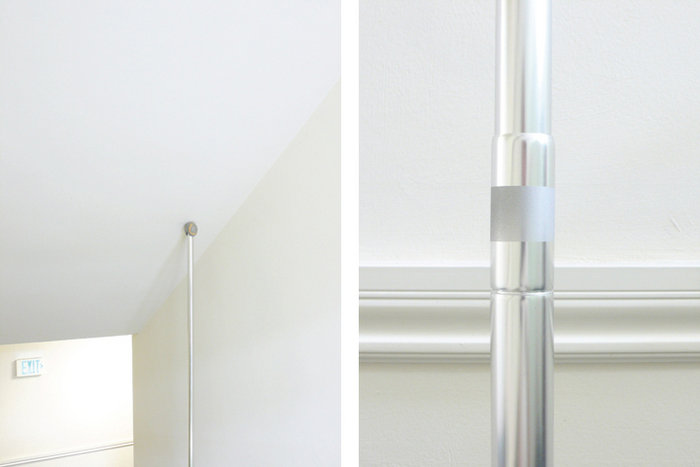
© » KADIST
Chadwick Rantanen
Telescopic Pole is an adjustable telescopic pole that extends vertically from floor to ceiling and is held up by its own internal pressure. The ends, protected by two, cut-open tennis balls, recall the legs of a walker. For Rantanen’s second solo exhibition at Jancar Jones Gallery, San Francisco in 2010, one pole was placed inside the gallery while the other was located outside.

© » KADIST
Alexandre da Cunha
Glaze (Savana) (2005) is an assemblage of found materials: a car wheel, a tire, and a wooden plinth of the type traditionally used to display sculpture. It directly engages with the readymade, a subject that Alexandre de Cunha takes up throughout his practice, often inflecting it with a tropical, and South American–inspired materiality and painterly style that could potentially come across as a stereotype. Here, da Cunha transforms the component parts into a composition that highlights often-overlooked materials of artistic production and cultural mass-production.

© » KADIST
Alexis Smith
Iron Sorrows (1990) brings together what are for Alexis Smith common motifs and materials such as scavenged and repurposed metal, and street signage. Iron is one of nature’s most abundant metals. Smith, a philosopher of human detritus and poetic associations, presents it in this work as simultaneously everywhere yet paradoxically forgotten, lost in the heaps of refuse that fill junkyards and vacant lots.
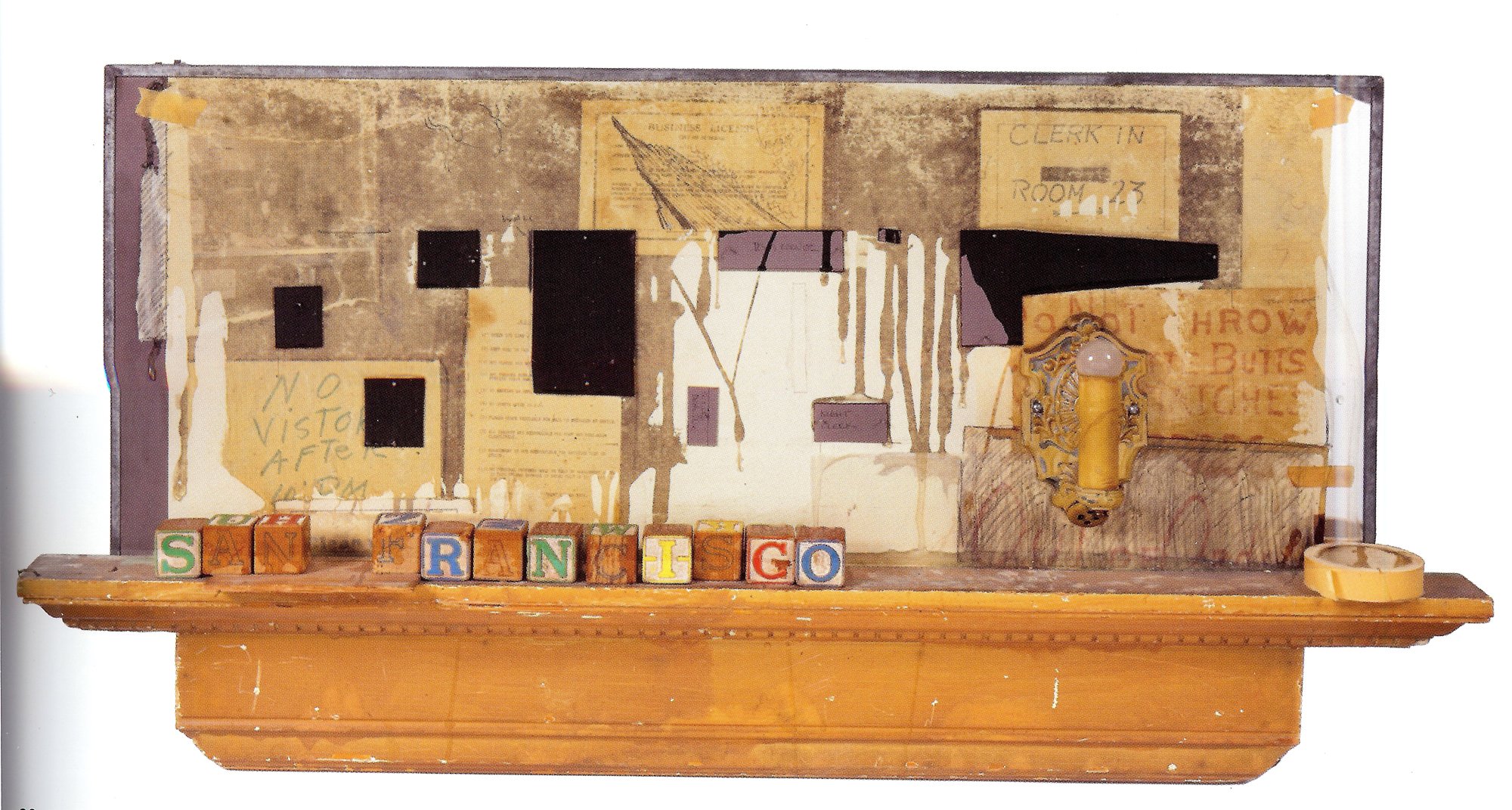
© » KADIST
Edward Kienholz
Untitled (San Francisco) was made in Idaho in 1984 and was facetiously dedicated to Henry Hopkins, the then director of the San Francisco Museum of Art who added “modern” to its name. Assembled from the remnants and found objects from a hotel room, including a collage, shelf and small lamp, this playful piece—a satirical shrine of sorts—echoes the decidedly un-modern spirit of San Francisco’s bohemian culture. Kienholz’s works, with their critical and anti-establishment content, are often linked to the 1960s Funk Art movement in the Bay Area.

© » KADIST
Alexandre da Cunha
In Laissez-Faire (Rainbow Flag) da Cunha has turned a beach towel into both a painting and a flag. Where the printed surface of the towel originally served to enliven this commodity, here the pattern—now stretched and re-presented—suddenly refers to abstract painting’s promises of transcendence. And its crisply painted shape pulls the printed colors into the rectangularity of the canvas and, as da Cunha notes, the graphic iconicity of flags.

© » KADIST
Minouk Lim
The Possibility of the Half by Minouk Lim is a two-channel video projection that begins with a mirror image of a weeping woman kneeling on the ground. As both frames progresses, a montage of large crowds of mourners are depicted in slow motion interwoven with a variety of images including bomb explosions, fireworks, vacant stores, sunsets and sunrises, beachside landscapes, and infrared shots. At midpoint, life in the year 4012 is foreshadowed down to living insects and the video concludes back in the year 2012 as a burning inferno.

© » KADIST
Alexandre da Cunha
The series West (Flag 1), West (Flag 3), and West (Flag 6) continues da Cunha’s ongoing exploration of the form’s various vertical, horizontal, and diagonal stripes. Here, da Cunha overlays thick bars of color (blue, green, and red) on photographs of the ocean at sunset with surfers in floating on the horizon. The solid colors contrast with the fading colors reflected in the sunset, and the tilted orientation suggests a familiar California beach scene.

© » KADIST
Bruce Conner
Unlike many of his earlier films which often present poignant critiques of mass media and its deleterious effects on American culture, EASTER MORNING , Conner’s final video work before his death in 2008, constitutes a far more meditative filmic essay in which a limited amount of images turn into compelling, almost hypnotic visual experience. The video presents us with a reinterpretation of footage from his unreleased avant-garde film, Easter Morning Raga , from 1966. In contrast to his more famous pieces like A Movie (1958) and Crossroads (1976) which are juxtapositions of fragments from newsreels, soft-core pornography, and B movies, the images in EASTER MORNING serve as a reinterpretation of footage.
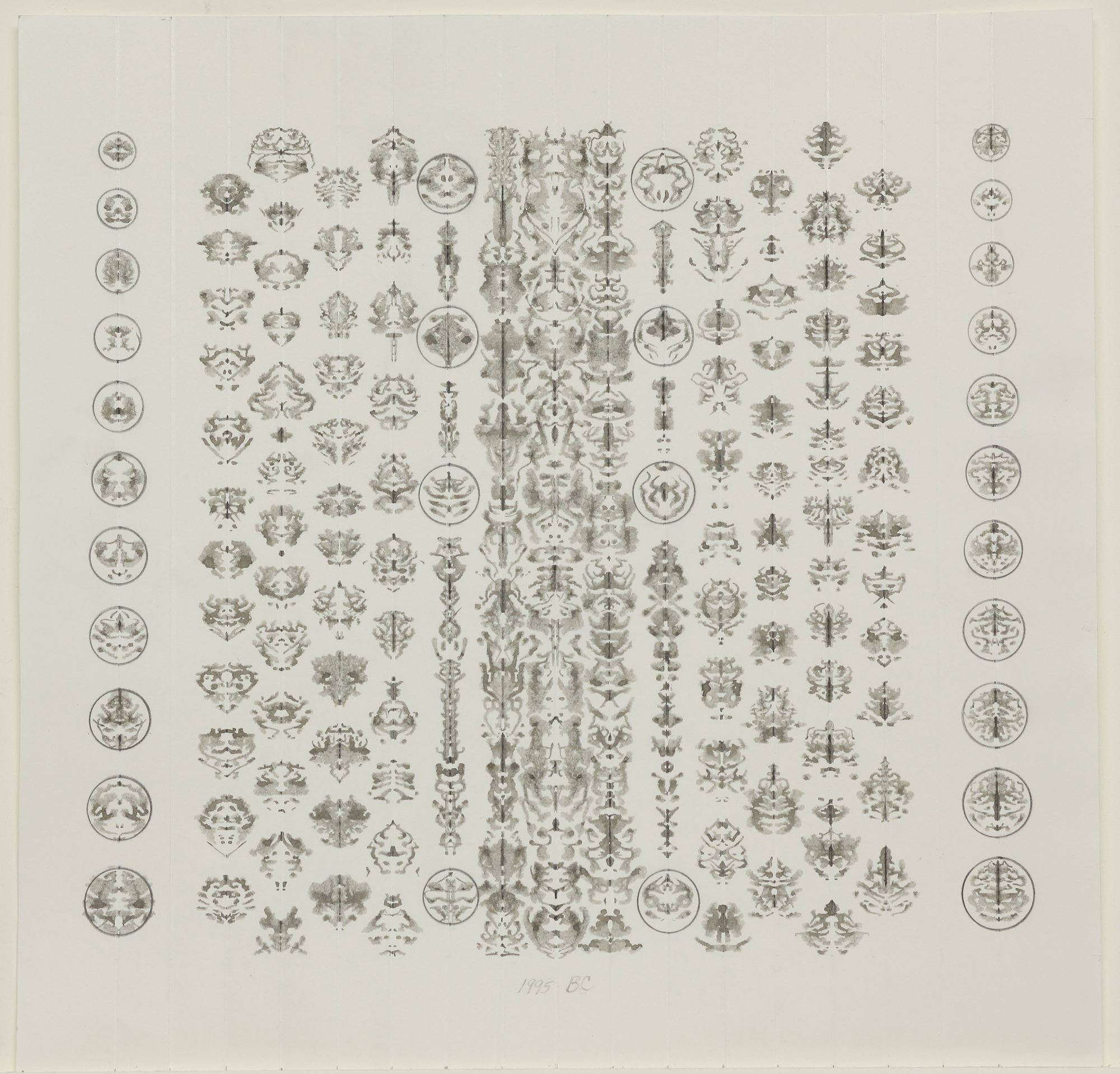
© » KADIST
Bruce Conner
Drawing & Print (Drawing & Print)
Bruce Conner is best known for his experimental films, but throughout his career he also worked with pen, ink, and paper to create drawings ranging from psychedelic patterns to repetitious inkblot compositions. Untitled Inkblot Drawing (CT-1491) (1995) is representative of his aspect of his practice. It is a formal exploration related to many different things: the Rorschach inkblot testing used by psychologists, Japanese calligraphy, Egyptian hieroglyphs, and the intricate patterning Conner saw everywhere in the world around him.

© » KADIST
Mike Kelley
Towhead n’Ganga, enclosed in darkness, lorded over by the sexualized folded high priestless form reflects many of Kelley’s works, in both its compositional and semantic qualities. The drawing on wood, the popcorn mixture, and the title all manifest a bumpy fullness, a “more-is-more” conflation between supposedly eternal spirituality and everyday stuff. The work’s title points to a serious timelessness completely belied by the materials.
Alexandre da Cunha
- location: London, United Kingdom
- year born: 1969
- gender: male
- nationality: Brazilian
- home town: Rio de Janeiro, Brazil
Kwan Sheung Chi
Kwan Sheung Chi obtained a third honor B.A...
Bruce Conner
- location: San Francisco, California
- year born: 1933
- gender: male
- nationality: American
- home town: McPherson, Kansas
Zai Kuning
- year born: 1964
- gender: male
- nationality: Singaporean
- home town: Singapore
Wallace Berman
- location: California
- year born: 1926
- gender: male
- nationality: American
- home town: Staten Island, New York
Alexis Smith
- location: Los Angeles, California
- year born: 1949
- gender: female
- nationality: American
- home town: Los Angeles, California
Minouk Lim
- location: Seoul, South Korea
- year born: 1968
- gender: female
- nationality: Korean
Mike Kelley
- location: Los Angeles, California
- year born: 1954
- gender: male
- nationality: American
- home town: Detroit, Michigan
Choi Jeong-Hwa
- year born: 1961
- gender: male
- nationality: Korean
- home town: Seoul, South Korea
Bjorn Copeland
- location: New York, New York
- gender: male
Yoan Capote
- location: Havana, Cuba
- year born: 1977
- gender: male
- nationality: Cuban
Chadwick Rantanen
- location: Los Angeles, California
- year born: 1981
- gender: male
- nationality: American
- home town: Wausau, Wisconsin
Barbara Kasten
- year born: 1936
- gender: female
- nationality: American
- home town: Chicago, Illinois
Edward Kienholz
- location: Los Angeles, California
- year born: 1927
- gender: male
- nationality: American
- home town: Fairfield, Washington
-
1960-1969
Wallace Berman
1969While Untitled (Shuffle) presents the same formal characteristics as the rest of Berman’s verifax collages, this constellation of specific images inside the radio’s frames—the Star of David, Hebrew characters, biblical animals—have Jewish symbolism and attest to the artist’s lasting obsession with the kabala...
-
1970-1979
Bruce Conner
1978In 1977, as an already-established artist best known for his films, Bruce Conner began to photograph punk rock shows at Mabuhay Gardens, a San Francisco club and music venue...
-
1980-1989
Edward Kienholz
1984Untitled (San Francisco) was made in Idaho in 1984 and was facetiously dedicated to Henry Hopkins, the then director of the San Francisco Museum of Art who added “modern” to its name...
-
1990-1999
Alexis Smith
1990Iron Sorrows (1990) brings together what are for Alexis Smith common motifs and materials such as scavenged and repurposed metal, and street signage...
Alexis Smith
1995In 8 Ball Surfboard (1995),Alexis Smith combines her long-term interests in California culture and conceptual assemblage...
Bruce Conner
Drawing & Print
1995(Drawing & Print) Bruce Conner is best known for his experimental films, but throughout his career he also worked with pen, ink, and paper to create drawings ranging from psychedelic patterns to repetitious inkblot compositions...
Mike Kelley
1996Towhead n’Ganga, enclosed in darkness, lorded over by the sexualized folded high priestless form reflects many of Kelley’s works, in both its compositional and semantic qualities...
-
2000-2009
Alexandre da Cunha
2005His Deck Painting I recalls the simplistic stripes of conceptual artist Daniel Buren, or the minimal lines of twentieth century abstract painting, but is in reality a readymade, fashioned from repurposed fabric of deck chairs...
Alexandre da Cunha
2005Glaze (Savana) (2005) is an assemblage of found materials: a car wheel, a tire, and a wooden plinth of the type traditionally used to display sculpture...
Kwan Sheung Chi
2007A Flags-Raising-Lowering Ceremony at my home’s cloths drying rack (2007) was realized in the year of the 10th anniversary of the establishment of The Hong Kong Special Administrative Region of the People’s Republic of China...
Yoan Capote
2007Open Mind is a model created by Capote for a traversable public maze that, when seen from above, resembles the human brain...
Choi Jeong-Hwa
2008The application of bright colors and kitsch materials in Flower Tree manifests a playful comment on the influence of popular culture and urban lifestyle...
Barbara Kasten
2008Barbara Kasten’s Studio Construct 51 depicts an abstract still life: a greyscale photograph of clear translucent panes assembled into geometric forms, the hard lines of their edges converging and bisecting at various points...
Bruce Conner
2008Unlike many of his earlier films which often present poignant critiques of mass media and its deleterious effects on American culture, EASTER MORNING , Conner’s final video work before his death in 2008, constitutes a far more meditative filmic essay in which a limited amount of images turn into compelling, almost hypnotic visual experience...
Bjorn Copeland
2009Sign #1 , Sign #2 , Sign #3 were included in “Found Object Assembly”, Copeland’s 2009 solo show at Jack Hanley Gallery, San Francisco...
-
2010-2019
Chadwick Rantanen
2010Telescopic Pole is an adjustable telescopic pole that extends vertically from floor to ceiling and is held up by its own internal pressure...
Alexandre da Cunha
2010In Laissez-Faire (Rainbow Flag) da Cunha has turned a beach towel into both a painting and a flag...
Alexandre da Cunha
2011The series West (Flag 1), West (Flag 3), and West (Flag 6) continues da Cunha’s ongoing exploration of the form’s various vertical, horizontal, and diagonal stripes...
Kwan Sheung Chi
2012Kwan Sheung Chi’s work One Million is a video work depicting the counting of bills...
Minouk Lim
2012The Possibility of the Half by Minouk Lim is a two-channel video projection that begins with a mirror image of a weeping woman kneeling on the ground...
Zai Kuning
2014Justice (2014) presents viewers with a curious assemblage: a wooden gallows with slightly curved spindles protruding from the topmost plank, which in turn is covered with rudimentary netting, the threads slackly dangling like a loose spider’s web or an rib cage that’s been cracked open...
Zai Kuning
Drawing & Print
2014(Drawing & Print) Converting is a piece about the Orang Laut, often called Sea Nomads, that inhabited the Riau archipelago...
Zai Kuning
Drawing & Print
2014(Drawing & Print) Concerned with the early history of Singapore, Zai Kuning spent many years living with and researching the history of the Riau peoples who were the first inhabitants of Singapore...

